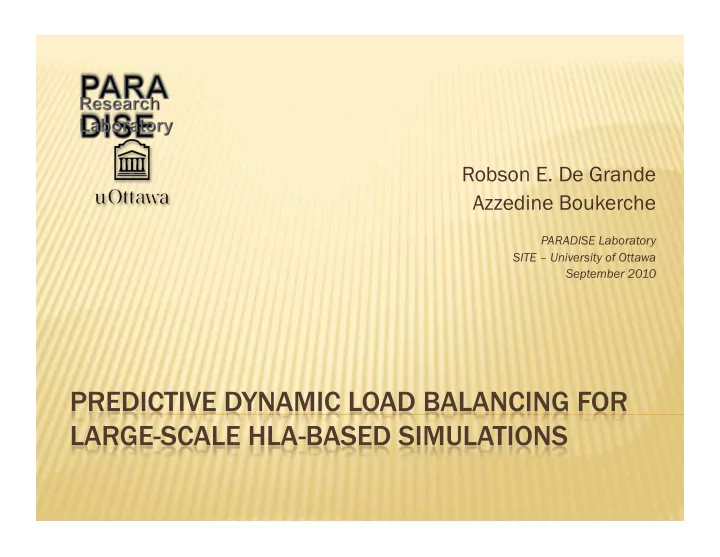

Robson E. De Grande Azzedine Boukerche PARADISE Laboratory SITE – University of Ottawa September 2010
DS-RT 2011 . Introduction High Level Architecture Dynamic Load Balancing Related Work Challenging Issues Proposed Balancing Scheme Architecture Functioning Prediction Model Experiments and Results Conclusion and Future Work 2
DS-RT 2011 . High Level Architecture Coordination of Distributed Simulations Interoperability and Reusability No management of resources Load Imbalances DDM only Communication Filtering It partially works for communication balancing 3
DS-RT 2011 . Grids services Resource Sharing Management System Grids + Stateful Web Services Access/Monitoring/Authentication – VO/Data Replication Globus ToolKit 4
DS-RT 2011 . Dynamic Load Balancing Static partitioning Deterministic processing On demand adaptation Unpredictable changes Large-scale environments Heterogeneity Shared resources Large communication latencies 5
DS-RT 2011 . Sim Monitoring Migration Heterog. Re-distribution Ext. load Glazer & Opt t advance comp - partially partially Tropper Jiang et al. Opt t advance comp - weights partially Burdorf & Marti Opt LVT/vector comp/speed/StD simple/slow partially partially Schlagenhaft Opt VTP comp/pVTP + mig vague partially partially et. al. Avril & Tropper Opt comm/ load (comm) vague partially partially throughput Carothers & Opt PAT load (policies) clustered/ partially partially Fujimoto slow Jiang et al. Opt IPC comp+comm clustered/ partially partially slow 6
DS-RT 2011 . Sim Monitoring Re-distribution Migration Heterog. Ext. load Deelman & Opt unproc event comp (chains) neighbor - - Szymanski Choe & Tropper Opt space-time comp vague partially partially product Low Opt *CPU load comm/comp/ - - - lookahead Peschlow et. al. Opt t advance comm/comp - partially partially Wilson & Shen Disc CPU load policies (comm/ - - - comp) Boukerche & Con CPU load comm/comp - - - Das Xiao et. al. Con comm dep sched lvl - - - 7
DS-RT 2011 . Sim Monitoring Migration Heterog. Re-distribution Ext. load Gan et. al. Con Sim time Central (priority) - - - Boukerche Con Entropy (!) Comp+comm - - - Ajaltouni et. al. Con CPU load Comm/comp Global sync - - Luthi & HLA - - Global sync - - Grossmman Zajac et. al. HLA Grids - Global sync - Monitor Cai et. al. HLA Grids - Global sync - Monitor Tan & Lim HLA - - queues - - Bononi et. al. HLA Comm. Dep Comm Fed objects Partially - Grande & HLA Comm. Dep/ Comm/comp Freeze free yes yes Boukerche CPU load 8
DS-RT 2011 . A balancing approach fully covers Heterogeneity External background load Scalability HLA simulation characteristics However Responsiveness Lack of efficiency Totally reactive scheme Cyclic load oscillations Precipitated load transfers 9
DS-RT 2011 . Architecture 10
DS-RT 2011 . Reactive Balancing cycles Load Balancing in 3 phases Monitoring Data gathering Detection of imbalances Re-distribution Migration Prediction Detection Re-distribution 11
DS-RT 2011 . Collection Cluster WebMDS CPU load Normalization Local Management Java Library CPU load Hierarchical gathering LLBs and CLBs MDS DS Filtering Irrelevant data Non-managed resources Not balanced fe fed Overloaded nodes without federates fe fed Cut-off position fe fed 12
DS-RT 2011 . Hierarchical/Region structure Redistribution among neighbour CLBs Inter-relations between CLBs Two scopes Local Pair-match evaluations Cluster Comparisons between neighbours Pair-match evaluations 13
DS-RT 2011 . Detection/Redistribution Predictions current load status + [past,forecast] Different levels Short term Responsiveness to current imbalances Medium and Long terms Preventive measures for future load trends Local Scope Redistribution on each detection Inter-domain Scope 1 - Cluster load evaluation 2 - Redistribution on each detection 14
DS-RT 2011 . Load comparisons Ordered by prediction Short term Medium term Long term Emphasis on predictions closer to current time Inter-domain Ordered by prediction Selection of resource candidates In prediction scopes 15
DS-RT 2011 . Balancing cycles Uniformly spaced time intervals Time series Smoothing and Forecasting Past is considered to define a future load status 0 Double EWMA SP SP LP LP MP MP Load tendency Extrapolation of smoothing Future balancing cycles: SP, MP, and LP 16
DS-RT 2011 . Predictive adjustment Adjustment of balancing parameters Before pair-match analysis Direction analysis Source Destination 3 conditions enforcement 1 – Load difference is increasing Less imbalance tolerance 2 – One resource is stabilizing Intermediary tolerance 3 – Both resources are stabilizing More imbalance tolerance 17
DS-RT 2011 . 2-step migration Federate Fe Federate Fe No global synchronization Init F Ini File les Grids RFT Initialization files Status + + Status + + Message Me ssages s Me Message ssages s Peer-to-peer Execution state + messages MM’ ’ MM MM Less migration delay Wait -> state + messages Minimum latency Larger system’s reactivity Migration Proxy Facilitate transient data transfer 18
DS-RT 2011 . Experimental Scenario Federates deployed on a 56-machine distributed system Two clusters: 32 and 24 nodes Each federate communication + computation Emphasis on computation Synthetic load Scenario Tank fight simulation From 1 to 1000 federates 1 object per federate Predictive scheme Prediction ranges: 1, 3, 5 19
DS-RT 2011 . Static simulation load Increasing number of federates 1 to 1000 20
DS-RT 2011 . Static external load Increasing number of federates 1 to 1000 21
DS-RT 2011 . Dynamic simulation load Random, periodic load changes 1 to 1000 federates 22
DS-RT 2011 . Predictive, distributed balancing system Forecasting of computational load changes Three levels of prediction: Short term smoothing mostly Medium term Long term Efficiency gain Less unnecessary migrations Prevention of load imbalances Cyclic oscillations Future Work Further prediction analysis Migration time Cyclic load changes size of cycle period Heterogeneous simulations Other prediction models 23
DS-RT 2011 . Thanks 24
Recommend
More recommend